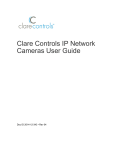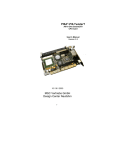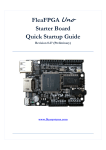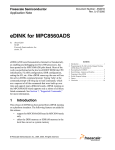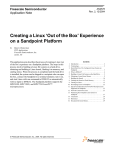Download sandpoint user manual 1.01
Transcript
Sandpoint User’s Manual Revision 1.01 Sandpoint User’s Manual 6/9/99 Revision 1.01 Preliminary copy, subject to change without notice Page 1 of 38 Revision 1.01 1 Sandpoint User’s Manual OVERVIEW .................................................................................................................................................. 4 1.1 Revision History..................................................................................................................................... 4 1.2 Introduction............................................................................................................................................ 5 1.3 Purpose ................................................................................................................................................. 5 1.3 Reference Documents ........................................................................................................................... 6 1.3.1 Motorola Documents ....................................................................................................................... 6 1.3.2 External Documents........................................................................................................................ 6 2 PRODUCT SUMMARY ................................................................................................................................. 7 3 SYSTEM CONFIGURATION ........................................................................................................................ 8 3.1 4 5 Block Diagram ....................................................................................................................................... 8 CHASSIS...................................................................................................................................................... 9 4.1 Slots ...................................................................................................................................................... 9 4.3 External CONTROLS & INDICATORS................................................................................................. 10 4.4 External connectors ............................................................................................................................. 11 INSTALLATION .......................................................................................................................................... 12 5.1 Motherboard diagram........................................................................................................................... 12 5.2 Jumpers and connectors Description.................................................................................................... 13 5.2.1 J11, J12, J13 PPMC Connectors................................................................................................... 14 5.2.2 J13, J14, J21 and J22 32-bit and 64-bit PCI Slot ........................................................................... 17 5.2.3 J16, J17 COM Ports...................................................................................................................... 19 5.2.4 J18 Parallel Port ........................................................................................................................... 19 5.2.5 J19,J20 PS/2 Keyboard and Mouse Connector.............................................................................. 20 5.2.6 J23 ATX Power Connector ............................................................................................................ 21 5.2.7 J25 CMOS Battery Connector ....................................................................................................... 22 5.2.8 J26, J27 IDE Connectors............................................................................................................... 23 5.2.9 J28 Floppy Disk Connector ........................................................................................................... 24 5.2.10 J29 Misc. Connectors.................................................................................................................... 25 5.2.11 J33 Test Clock Input ..................................................................................................................... 26 5.2.12 J34 66MHZ PCI Disable................................................................................................................ 26 5.2.13 S1 Power ON/OFF Switch............................................................................................................ 27 5.2.14 S2 Reset Switch............................................................................................................................ 27 5.2.15 S3, S4 Mode Selection Switch ...................................................................................................... 28 5.2.16 S5 Interrupt Inversion Switch ........................................................................................................ 29 5.2.17 S6 Shared interrupt Selection Switch ............................................................................................ 30 5.2.18 J30, J31 and J32 VIO Selection .................................................................................................. 31 5.3 Boot ROM............................................................................................................................................ 32 Page 2 of 38 Sandpoint User’s Manual 6 Revision 1.01 5.4 RTC and NVRAM................................................................................................................................. 32 5.5 DISPLAY ............................................................................................................................................. 32 5.6 IDE DRIVE (s)...................................................................................................................................... 32 5.7 Hard Drive Activity Indicator ................................................................................................................ 32 5.8 Floppy Drive(s) .................................................................................................................................... 32 5.9 Speaker ............................................................................................................................................... 33 5.10 Power Supply....................................................................................................................................... 33 KEY COMPONENTS .................................................................................................................................. 34 6.1 Winbond 83C553 ................................................................................................................................. 34 6.2 National Semiconductor PC87308........................................................................................................ 34 7 DINK32 DEBUG MONITOR ........................................................................................................................ 35 8 INTERRUPT CONFIGURATION................................................................................................................. 36 9 PCI SLOT INFORMATION.......................................................................................................................... 37 APPENDIX A: INTERCONNECTION DIAGRAM................................................................................................ 38 Page 3 of 38 Revision 1.01 Sandpoint User’s Manual 1 OVERVIEW 1.1 REVISION HISTORY Date Revision Distribution Comments 2/21/99 6/9/99 1.0 1.01 General Release ....................................For Sandpoint 1.0 General Release ....................................Correction on jumper setting description on S5 and S6. Please email your comments of this user’s manual to: RISC Hotline Email: [email protected] TRADEMARKS The PowerPC name, the PowerPC logotype, PowerPC 603, PowerPC740, and PowerPC750 and are trademarks of International Business Machines Corporation used by Motorola under license from International Business Machines Corporation All other trademarks are the property of their respective owner(s) This document contains information on a new product under development. Specifications and information herein are subject to change without notice. Page 4 of 38 Sandpoint User’s Manual 1.2 Revision 1.01 INTRODUCTION This document describes the features of the “Sandpoint” Processor PCI Mezzanine Card (PPMC) host board. This board contains one PMC/PPMC – compatible slot, four PCI slots and complement of standard PC motherboard logic such as an ISA bridge, serial, parallel, keyboard/mouse, floppy and IDE disk controllers. Sandpoint is intended for hardware and software development and evaluation purpose only, and is not intended for operation in commercial environments. 1.3 PURPOSE The Sandpoint PPMC host board design has various uses including, but not limited to: - System suitable to showcase the 8240 PMC, 7XX PMC and the other future PPMC solution - System for use by customers in benchmarking, compatibility testing, firmware development etc. - Software debug platform for embedded application. - Development platform for use by third-parties firmware/utility developers. It should be noted that Sandpoint is not intended only for purposes such as that outlined above and is not intended to be sold as a Motorola product. Page 5 of 38 Revision 1.01 Sandpoint User’s Manual 1.3 REFERENCE DOCUMENTS 1.3.1 Motorola Documents - 1.3.2 PowerPC Microprocessor Family: The Programming Environments manual PowerPC 603e User’s manual PowerPC 740 User’s manual PowerPC 750 User’s manual PowerPC 106 Chipset Implementation Definition PowerPC 8240 User’s manual Sandpoint Hardware Reference Manual External Documents - Page 6 of 38 Peripheral Component Interconnect (PCI) Specification Rev 2.1 Draft Standard Physical and Environmental layers for PCI Mezzanine Cards: PMC (IEEE P1386.1/Draft 2.0 04-Apr-1995) Draft Standard Physical and Environmental Layers for Processor PCI Mezzanine Cards: PPMC (XXXX P1386.X/Draft 0.1 15-Feb-1998) Draft Standard for a Common Mezzanine Card Family: CMC (IEEE P1386/Draft 2.0 04-Apr-1995) ATX Specification version 1.0 Sandpoint User’s Manual 2 Revision 1.01 PRODUCT SUMMARY The Sandpoint motherboard is a “host” board, which accepts a PMC or PPMC card as well as up to four PCI slots. The host board has the following features: PMC and PPMC support - One PMC slot with PPMC, 64-bit and 66MHz extensions Switch-selectable operating modes Four PCI slots: 2 5V/32-bit slots, 2 3.3V/64-bit slots PCI slots support 33 or 66 MHz operation Two standard 16650-compatible ESD-protected serial ports IEEE 1284 parallel port Floppy disk port Two IDE ports PS/2 Mouse and keyboard connectors NVRAM and real-time clock (RTC) Advanced Power Controller (“soft on/off) LED monitors for critical functions Automatic sense of PCI bus speed (33 or 66 MHz) Flash EPROM for boot firmware ATX chassis with ATX power supply DINK32 Debug Monitor Software in ROM Notes: The I/O subsystem is identical to that of “EC”version of the Yellowknife development platform, Current PowerPC evaluation system. When properly configured, software written for the Yellowknife platform should operate identically when executed on a Sandpoint. Page 7 of 38 Revision 1.01 3 SYSTEM CONFIGURATION 3.1 BLOCK DIAGRAM Sandpoint User’s Manual The following is the block diagram of the Sandpoint: Page 8 of 38 Sandpoint User’s Manual 4 Revision 1.01 CHASSIS The Sandpoint use the ATX format chassis which had external drive bays for additional upgrade. 4.1 SLOTS The Sandpoint chassis supports a total of four PCI slots for add-in cards. Two of the PCI slots are 32-bit and reminding two are 64-bit slots. Page 9 of 38 Revision 1.01 4.3 Sandpoint User’s Manual EXTERNAL CONTROLS & INDICATORS The following diagram shows the front panel of the Sandpoint system: On-Off Switch Power On indicator Reset Switch Page 10 of 38 Sandpoint User’s Manual 4.4 Revision 1.01 EXTERNAL CONNECTORS The following show the back panel on the ATX chassis: ATX Power Supply Serial Port 1 PS/2 Keyboard PS/2 mouse Parallel Port Optional Serial and Parallel Ports Serial Port 2 64-bit PCI 64-bit PCI PCI Slot X 4 32-bit PCI 32-bit PCI Page 11 of 38 Revision 1.01 5 INSTALLATION 5.1 MOTHERBOARD DIAGRAM Sandpoint User’s Manual The following is the Sandpoint motherboard diagram: Page 12 of 38 Sandpoint User’s Manual 5.2 Revision 1.01 JUMPERS AND CONNECTORS DESCRIPTION 1) J11 2) J12 3) J13 4) J14 5) J15 6) J16 7) J18 8) J19 9) J20 10) J21 11) J22 12) J23 13) J25 14) J26 15) J27 16) J28 17) J29 18) J30,31,32 19) J33 20) J34 21) S1 22) S2 23) S3,S4 24) S5 25) S6 PMC Connector 1 (64-pin) PMC connector 2 (64-pin) PMC connector 3 (64-pin) 64-bit PCI slot 64-bit PCI slot COM1 port Parallel Port PS/2 Keyboard connector PS/2 Mouse connector 32-bit PCI slot 32-bit PCI slot ATX Connector Battery connector Primary IDE connector Secondary IDE connector Floppy Disk connector Misc. connectors (Reset, PowerON, Speaker) VIO selection jumpers Test Clock Input 66MHz PCI Disable Power On/Off Switch Reset Switch Mode Selection Switch Interrupt Inversion Switch Shared Interrupt Selection Switch Page 13 of 38 Revision 1.01 5.2.1 Sandpoint User’s Manual J11, J12, J13 PPMC Connectors 2 J12 1 2 Pn2 2 J11 1 J13 1 Pn1 Pn3 Note: 8240 PMC uses only J11 and J12 connectors Pn1/J11 32 Bit PCI pin description Pin # 1 3 5 7 9 11 13 15 17 19 21 23 25 27 29 31 33 35 37 39 41 43 45 47 49 51 53 55 57 59 61 63 Signal Name TCK Ground INTB# PRESENT# INTD# Ground PCICLK Ground REQ#/XGNT[0]# V(I/O) AD[28] AD[25] Ground AD[22] AD[19] V(I/O) FRAME# Ground DEVSEL# Ground SDONE# PAR V(I/O) AD[12] AD[09] Ground AD[06] AD[04] V(I/O) AD[02] AD[00] Ground Page 14 of 38 Signal Name -12V INTA# INTC# +5V PCI-RSVD PCI-RSVD Ground GNT#/XREQ[0]# +5V AD[31] AD[27] Ground C/BE[3]# AD[21] +5V AD[17] Ground IRDY# +5V LOCK# SBO# Ground AD[15] AD[11] +5V C/BE[0]# AD[05] Ground AD[03] AD[01] +5V REQ64# Pin # 2 4 6 8 10 12 14 16 18 20 22 24 26 28 30 32 34 36 38 40 42 44 46 48 50 52 54 56 58 60 62 64 Sandpoint User’s Manual Revision 1.01 Pn2/J12 32Bit PCI Pin Description Pin # 1 3 5 7 9 11 13 15 17 19 21 23 25 27 29 31 33 35 37 39 41 43 45 47 49 51 53 55 57 59 61 63 Signal Name +12V TMS TDI Ground PCI-RSVD XREQ[1]# RST# +3.3V PCI-RSVD AD[30] Ground AD[24] IDSEL +3.3V AD[18] AD[16] Ground TRDY# Ground PERR# +3.3V C/BE[1]# AD[14] M66EN AD[08] AD[07] +3.3V XGNT[1]# XGNT[2]# Ground ACK64# Ground Signal Name TRST# TDO Ground PCI-RSVD PCI-RSVD +3.3V XREQ[2]# XREQ[3]# Ground AD[29] AD[26] +3.3V AD[23] AD[20] Ground C/BE[2]# PMC-RSVD +3.3V STOP# Ground SERR# Ground AD[13] AD[10] +3.3V PMC-RSVD PMC-RSVD Ground XGNT[3]# PMC-RSVD +3.3V SYSCON# Pin # 2 4 6 8 10 12 14 16 18 20 22 24 26 28 30 32 34 36 38 40 42 44 46 48 50 52 54 56 58 60 62 64 Page 15 of 38 Revision 1.01 Sandpoint User’s Manual Pn3/J13 64 Bit PCI Pin Description Pin # 1 3 5 7 9 11 13 15 17 19 21 23 25 27 29 31 33 35 37 39 41 43 45 47 49 51 53 55 57 59 61 63 Signal Name PCI-RSVD Ground C/BE[6]# C/BE[4]# V(I/O) AD[63] AD[61] Ground AD[59] AD[57] V(I/O) AD[55] AD[53] Ground AD[51] AD[49] Ground AD[47] AD[45] V(I/O) AD[43] AD[41] Ground AD[39] AD[37] Ground AD[35] AD[33] V(I/O) PCI-RSVD PCI-RSVD Ground Page 16 of 38 Signal Name Ground C/BE[7]# C/BE[5]# Ground PAR64 AD[62] Ground AD[60] AD[58] Ground AD[56] AD[54] Ground AD[52] AD[50] Ground AD[48] AD[46] Ground AD[44] AD[42] Ground AD[40] AD[38] Ground AD[36] AD[34] Ground AD[32] PCI-RSVD Ground PCI-RSVD Pin # 2 4 6 8 10 12 14 16 18 20 22 24 26 28 30 32 34 36 38 40 42 44 46 48 50 52 54 56 58 60 62 64 Sandpoint User’s Manual 5.2.2 Revision 1.01 J13, J14, J21 and J22 32-bit and 64-bit PCI Slot Slot 3 J21-32-bit Slot 4 J22-32-bit Slot 1 Slot 2 J14-64-bit J15-64-bit Sandpoint has three PCI slots (PCI 1, PCI 2 and PCI 3). The connectors, pin assignments, signal timings, loadings and mechanical dimensions all conform to the standard PCI specification. The pin assignment for the PCI connectors is as follows: Pin B1 B2 B3 B4 B5 B6 B7 B8 B9 B10 B11 B12 B13 B14 B15 B16 B17 B18 B19 B20 B21 B22 B23 B24 B25 B26 B27 B28 B29 B30 B31 B32 B33 B34 B35 B36 B37 B38 B39 Description -12V TCK GROUND TD0 +5V +5V INTB* INTD* PRSNT1* RESERVED PRSNT2* GROUND GROUND RESERVED GROUND CLK GROUND REQ* +5V (I/O) AD31 AD29 GROUND AD27 AD25 +3.3V C/BE*3 AD23 GROUND AD21 AD19 +3.3V AD17 C/BE*2 GROUND IRDY* +3.3V DEVSEL* GROUND LOCK* Pin A1 A2 A3 A4 A5 A6 A7 A8 A9 A10 A11 A12 A13 A14 A15 A16 A17 A18 A19 A20 A21 A22 A23 A24 A25 A26 A27 A28 A29 A30 A31 A32 A33 A34 A35 A36 A37 A38 A39 Description TRST* +12V TMS TDI +5V INTA* INTC* +5V RESERVED +5V RESERVED GROUND GROUND RESERVED RST* +5V (I/O) GNT* GROUND RESERVED AD30 +3.3V AD28 AD26 GROUND AD24 IDSEL +3.3V AD22 AD20 GROUND AD18 AD16 +3.3V FRAME* GROUND TRDY* GROUND STOP* +3.3V Comment 32-bit connector starts Page 17 of 38 Revision 1.01 Sandpoint User’s Manual B40 PERR* B41 B42 B43 B44 B45 B46 B47 B48 B49 B50 B51 B52 B53 B54 B55 B56 B57 B58 B59 B60 B61 B62 +3.3V SERR* +3.3V C/BE*1 AD14 GROUND AD12 AD10 GROUND (KEY) (KEY) AD8 AD7 +3.3V AD5 AD3 GROUND AD1 +5V (I/O) ACK64* +5V +5V B63 B64 B65 B66 B67 B68 B69 B70 B71 B72 B73 B74 B75 B76 B77 B78 B79 B80 B81 B82 B83 B84 B85 B86 B87 B88 B89 B90 B91 B92 B93 B94 Page 18 of 38 RESERVED GROUND C/BE[6]# C/BE[4]# GROUND AD[63] AD[61] +3.3V AD[59] AD[57] GROUND AD[55] AD[53] GROUND AD[51] AD[49] +3.3V AD[47] AD[45] GROUND AD[43] AD[41] GROUND AD[39] AD[37] +3.3V AD[35] AD[33] GROUND RESERVED RESERVED GROUND A40 A41 A42 A43 A44 A45 A46 A47 A48 A49 A50 A51 A52 A53 A54 A55 A56 A57 A58 A59 A60 A61 A62 Connector Key A63 A64 A65 A66 A67 A68 A69 A70 A71 A72 A73 A74 A75 A76 A77 A78 A79 A80 A81 A82 A83 A84 A85 A86 A87 A88 A89 A90 A91 A92 A93 A94 SDONE 32-bit connectors continued SBO* GROUND PAR AD15 +3.3V AD13 AD11 GROUND AD9 (KEY) (KEY) C/BE*0 +3.3V AD6 AD4 GROUND AD2 AD0 +5V (I/O) REQ64* +5V +5V 64-bit spacer GROUND C/BE[7]# C/BE[5]# +3.3V PAR64 AD[62] GROUND AD[60] AD[58] GROUND AD[56] AD[54] +3.3V AD[52] AD[50] GROUND AD[48] AD[46] GROUND AD[44] AD[42] +3.3V AD[40] AD[38] GROUND AD[36] AD[34] GROUND AD[32] RESERVED GROUND RESERVED 64-bit connector start 64-bit connector end Sandpoint User’s Manual 5.2.3 Revision 1.01 J16, J17 COM Ports Sandpoint has two 16550-compatible serial ports. PC serial connectors are located at the back panel. PC serial port pin assignment J17- COM2 1 J16- COM1 Pin 1 2 3 4 5 6 7 8 9 5.2.4 Signal DCD SIN SOUT DTR GND DSR RTS CTS RI I/O I I O O N/A I O I I 5 6 9 Definition Data carrier detect Serial input Serial output Data terminal ready Signal GND Data Set Ready Request To Send Clear To Send Ring Indicator J18 Parallel Port Sandpoint has one AT-compatible, bi-directional parallel port. This connector is located at the back panel. J18 1 1 2 1 Page 19 of 38 Revision 1.01 Sandpoint User’s Manual Pin 1 2 3 4 5 6 7 8 9 10 11 12 13 14 15 16 17 18-25 5.2.5 Signal STB# PD0 PD1 PD2 PD3 PD4 PD5 PD6 PD7 ACK# BUSY PE SLCT AFD# ERR# INIT# SLIN# GND I/O I/O I/O I/O I/O I/O I/O I/O I/O I/O I I I I O I O O N/A Definition Strobe Printer data bit o Printer data bit 1 Printer data bit 2 Printer data bit 3 Printer data bit 4 Printer data bit 5 Printer data bit 6 Printer data bit 7 Acknowledge Busy Paper end Select Automatic Feed Error Initialize printer Select in Signal GND J19,J20 PS/2 Keyboard and Mouse Connector Sandpoint supports both the AT-compatible keyboard interfaces. PS/2 keyboard connectors are located at the back panel. J19 PS/2 Keyboard 6 5 4 2 The following is the PS/2 Keyboard pin definition: Pin 1 2 3 4 5 6 Page 20 of 38 Signal KBDATA NC GND FVcc KBCLK NC 3 I/O I/O N/A N/A N/A I/O N/A Definition Keyboard data No connection Signal GND Fused supply voltage Keyboard clock No connection 1 Sandpoint User’s Manual Shell N/A N/A Revision 1.01 Chassis GND Sandpoint supports both the PS/2 compatible mouse The PS/2 mouse is supported through the mouse port. PS/2 mouse connector is located at the back panel. PS/2 mouse connector pin assignment J19 PS/2 Mouse 6 5 4 3 2 Pin 1 2 3 4 5 6 Shell 5.2.6 Signal MFDATA NC GND FVcc I/O I/O N/A N/A N/A KBCLK NC N/A I/O N/A N/A 1 Definition Mouse data No connection Signal GND Fused supply voltage Mouse clock No connection Chassis GND J23 ATX Power Connector Sandpoint uses the standard ATX power supply, which provide the 5V and 3.3V to the motherboard. The following is the power connector pin assignment: 1 Page 21 of 38 Revision 1.01 Sandpoint User’s Manual Pin 1 2 3 4 5 6 7 8 9 10 5.2.7 Signal +3.3V +3.3V GND VCC GND VCC GND PWRGOOD VSTDBY +12V Pin 11 12 13 14 15 16 17 18 19 20 Signal +3.3V -12V GND PS_ON GND GND GND -5V VCC VCC J25 CMOS Battery Connector 1 Connect the CMOS battery connector to either 1-4 Page 22 of 38 Battery Key NC GND Sandpoint User’s Manual 5.2.8 Revision 1.01 J26, J27 IDE Connectors The Enhanced IDE controller is built in the PCI-ISA bridge, two IDE connectors are on the motherboard to support both the enhanced IDE hard drives and the IDE CD-ROM. The IDE controller is part of the Winbond 553. See the Winbond 553 data book for additional information on the IDE controller. J26 1 J27 1 IDE1 IDE2 IDE connector pin assignment Pin 1 3 5 7 9 11 13 15 17 19 21 23 25 27 29 31 33 35 37 39 Signal IDERESET# IDED7 IDED6 IDED5 IDED4 IDED3 IDED2 IDED1 IDED0 GROUND IDEDRQ# IDEIOW# IDEIOR# N/C IDEACK# IDEIRQ IDESA1 IDESA0 IDECS0# DISKLED# Pin 2 4 6 8 10 12 14 16 18 20 22 24 26 28 30 32 34 36 38 40 Signal GND IDED8 IDED9 IDED10 IDED11 IDED12 IDED13 IDED14 IDED15 N.C. GND GND GND IDEBALE GND IDEIOCS16# N.C. IDESA2 IDECS1# GND Page 23 of 38 Revision 1.01 5.2.9 Sandpoint User’s Manual J28 Floppy Disk Connector Sandpoint incorporates a 34-pin Floppy disk connector to support the floppy disk drive. The floppy controller is in the National 308 Super I/O chip. See National 308 data book for additional information. J28 1 The pin assignment of the PC standard floppy disk drive is as follows: Pin 1 3 5 7 9 11 13 15 17 19 21 23 25 27 29 31 33 Page 24 of 38 Signal Gnd Gnd Gnd NC Gnd Gnd Gnd Gnd MSEN1 Gnd Gnd Gnd Gnd MSEN0 Gnd Gnd Gnd Pin 2 4 6 8 10 12 14 16 18 20 22 24 26 28 30 32 34 Signal DENSEL NC NC INDEX# MTR0# DRVSEL1# DRVSEL0# MTR1# DIR# STEP# WDATA# WGATE# TRK0# WRTPRT# RDATA# HDSEL# DSKCHG# Sandpoint User’s Manual Revision 1.01 5.2.10 J29 Misc. Connectors J29 SPKR PWR LED IR Port 1 2 PWR Switch Pin 1 3 5 7 9 11 13 15 17 19 21 23 25 27 29 31 33 STDBY PS on LED Signal VCC NC IRRX GND IRTX NC VCC NC GND NC GND NC NC PCSPKR NC GND VCC Pin 2 4 6 8 10 12 14 16 18 20 22 24 26 28 30 32 34 Disk LED Reset Signal GND RSTHDR# GND NC NC VCC DISKLED# DISKLED# VCC PS_ON# GND NC VSTDBY GND NC PWR_A PWR_B Page 25 of 38 Revision 1.01 Sandpoint User’s Manual 5.2.11 J33 Test Clock Input J33 If jumper J33 is installed, the on-board 66MHz oscillator is disabled and an external clock source is used to drive the PCI bus. The signal provided must be 3.3V LVTTL logic levels into a 50 ohms Load. The input clock is supplied as-is, or divided by two, depending upon the state of the M66EN (66MHz PCI) status and the 66MHz PCI Disable jumper. Care must be used that the devices receiving the clock are capable of and are configured to operate at the new clock speed. In particular, PowerPC devices have internal PLLs, which require a minimum clock input to operate properly. 5.2.12 J34 66MHZ PCI Disable J34 If jumper 34 is installed, the PCI bus will operate at 33MHz regardless of the status of the M66EN signal. The PCI bus ordinarily selects 66 MHz operation if (and only if) all PPMC and PCI devices installed support 66 MHz clock rates; otherwise, the slower 33MHz rate is used. However, for testing purposes, this jumper may be used to evaluate slower bus clock rates. In addition, it may be needed for systems using 66MHz-capable cards which also wish to use the Winbond or on-board I/O. Since these devices operate at 33MHz only, yet do not have an M66EN pin to control clock selection, jumper J34 is required to force the PCI bus to operate at 33MHz. Page 26 of 38 Sandpoint User’s Manual Revision 1.01 5.2.13 S1 Power ON/OFF Switch S1 Press once to power up the system. Press again to power off the system. SEE ERRATA 5.2.14 S2 Reset Switch S2 Press once to reset the system Page 27 of 38 Revision 1.01 Sandpoint User’s Manual 5.2.15 S3, S4 Mode Selection Switch Mode 0: PMC W/IDE Mode 2: PMC/Winbond Mode 1: PMC W/Slots Mode 3: Yellowknife To support existing Yellowknife/PPMC software environment, as well as the new Sandpoint/PPMC environment, Sandpoint supports four different modes, which are selectable via a pair of switches. The following table describes the modes. Mode Default 0 Name PPMC With IDE Host 1 PPMC Host with Slots 2 PPMC/Winbond 3 Yellowknife Description PPMC Host Mode W/IDE support: The PPMC slot is the system controller and provides arbitration and interrupt control. The Winbond IDE disk controllers replace slots 1 and 2 (3.3V PCI slots). The 5V PCI slots 3 and 4 are available. The on-board I/O shares interrupts with slots 2 or 3 PPMC Host Mode W/Four slot support: The PPMC slot is the system controller and provides arbitration and interrupt control. The Winbond IDE disk controllers are unavailable. All slots are available. The on-board I/O shares interrupts with slots 2 or 3 PPMC/Winbond Mode: The PMC slot is an agent, and the Winbond provides arbitration and interrupt control. The Winbond interrupt output drives the INTA# pin of the PPMC slot. Yellowknife Mode: The PPMC slot is an agent, and the Winbond provides arbitration and interrupt control. The Winbond interrupt output drives the INTA# pin of the forth PCI slot. Which mode should be selected? The first two modes are the principal modes, which will be used for new development, and can be selected between by deciding whether four PCI slots are needed or IDE is needed. Page 28 of 38 Sandpoint User’s Manual Revision 1.01 The Latter two modes are intended as transitional settings, and may be used to aid conversion from a modified Yellowknife platform, where a PPMC is connected through a PMC->PCI adapter card. This Yellowknife system is identical to a Sandpoint operating in mode 3. Mode 2 is architecturally similar except that the adapter card may be eliminated. Mode 2 is also useful for early PPMC cards such as the PPMC750, which do not include a PCI arbiter, since the Winbond provides this feature. The Sandpoint board uses switches to select one of the four configuration choices. Logic on the Sandpoint host board switches the connections of the PCI request/grant signals, the PCI interrupt signals, and the component configuration mode (SYSCON#, ARBDIS#, etc) to provide the required environment. Appendix A shows how the different signals on the motherboard are interconnected. 5.2.16 S5 Interrupt Inversion Switch Interrupt to PMC inverted S5 S5 Interrupt to PMC normal Some PPMC cards, such as the PPMC8240, are configured with active-high interrupt input when operated in the default configuration, which conflicts with PCI requirements. This is one example in which the MPC8240 is not quite identical to an MPC603+MPC106, so software moved as-is from the Yellowknife to the PPMC8240 will find interrupts are not working. The short term work-around is to configure Sandpoint to invert the PMC interrupt signal; since this violates the specs, it is intended only for a short term assistance; the correct solution is to program the EPIC of the MPC8240 to accept the correct polarity. Page 29 of 38 Revision 1.01 Sandpoint User’s Manual 5.2.17 S6 Shared interrupt Selection Switch Local I/O shared with Slot 3 S6 S6 Local I/O shared with Slot 2 PPMC cards support up to four interrupt sources. When operating in modes 0 or 1, there are a total of five possible interrupt sources (four slots and the winbond PIC (handling the local I/O resources such as serial ports)). When on-board I/O is needed, it must be shared with or replace PCI devices in slot 2 or slot 3. Software must poll multiple sources to determine the interrupt source if both the slot and local I/O are needed; otherwise, the slot can be left unused or used with non-interrupting devices such as graphics cards. To select which slot replaces/shares interrupts with the Sandpoint local I/O, set the switch as shown above. This switch setting is ignored when the board is configured in modes 2 or 3. Page 30 of 38 Sandpoint User’s Manual Revision 1.01 5.2.18 J30, J31 and J32 VIO Selection Jumpers J30, J31 and J32 are used to set the I/O voltage signaling level for the PPMC card. As with PCI slots, the PPMC slot provides the ability to provide I/O power on certain pins, and compatibility is maintained using keying methods (for PCI slots, a key is present in the slot, while for PPMC slots, a keying pin protrudes from the motherboard into the PPMC card). For flexibility in testing purposes, Sandpoint allows any types of VIO-Keyed board to be installed, with the proper VIO selected by jumper J30-J32. NOTE: This flexibility requires that the Sandpoint be configured to match the PPMC card before powering up. NOTE: All three jumpers must be set in an identical fashion; if any are different, the power supply will short and the board can be damaged or destroyed. 5V VIO 3.3V VIO 5V J30 5V J30 VIO J32 VIO J32 3.3V J31 3.3V J31 Page 31 of 38 Revision 1.01 5.3 Sandpoint User’s Manual BOOT ROM ROM Sandpoint incorporates a boot ROM which is implemented as a 4Mb (512Kbx8) flash EPROM. The BootROM contains the DINK32 boot code to support basic debug function. See the DINK32 user’s manual for more information. The boot ROM is physically located on the ISA bus. 5.4 RTC AND NVRAM Sandpoint incorporates an 8 KB battery-backed SRAM, which is organized as 8Kbx8 and is used for the storage of system configuration information such as: - 5.5 Passwords Boot record Global environment parameters Language data DISPLAY Sandpoint communicate with the terminal through serial port 1, the terminal needs to be VT-100 compatible. 5.6 IDE DRIVE (S) Sandpoint includes logic for a PCI bus Master IDE Interface. Two connectors are located on the motherboard to support the primary and secondary interface. 5.7 HARD DRIVE ACTIVITY INDICATOR The Sandpoint chassis incorporates a hard disk drive activity indicator that is ON when data is being transferred to/from any internal IDE drive. 5.8 FLOPPY DRIVE(S) Sandpoint supports 3.5” standard PC floppy disk drive. Page 32 of 38 Sandpoint User’s Manual 5.9 Revision 1.01 SPEAKER A PC-type 2.5”--diameter speaker is mounted on the inside of the chassis. 5.10 POWER SUPPLY Sandpoint incorporates a ATX format 250W PC-type power supply capable of supplying sufficient power at all required voltages to meet the needs of the supported motherboard, drives and add-in cards. The power supply is switchable externally between 100V/60Hz and 220V/50Hz operations. Page 33 of 38 Revision 1.01 6 Sandpoint User’s Manual KEY COMPONENTS The following table summarizes the key components used in the Sandpoint system: PCI-ISA Bridge I/O Controller Enhanced IDE controller NVRAM (RTC) 6.1 Winbond 83C553 National Semi PC87308VUL Built in the Winbond 83C553 Built in PC87308VUL WINBOND 83C553 The Sandpoint system uses the Winbond 83C553 PCI-ISA controller as a bridge to the ISA bus. This bridge provides the following functions: - 100% PCI and ISA compatible - Incorporates two 8237 DMA controllers - High performance PCI arbiter - Incorporates two 8259 interrupt controllers - One 82C54 16-bit counter/timer - Bus master IDE support for 4 IDE devices For more information on the Winbond chip, please refer to their user’s manual. 6.2 NATIONAL SEMICONDUCTOR PC87308 The PC87308 is a single chip super I/O controller. It incorporates in one fully Plug and Play compatible chip, a Floppy Disk controller, a Keyboard and mouse controller, a Real-time clock. two full function UARTs, infrared support, a full IEEE 1284 parallel port, three general purpose chip select signals, and support for power management functions. PC87308 also provide interface to the external SRAMs to provide the NVRAM functions. Page 34 of 38 Sandpoint User’s Manual 7 Revision 1.01 DINK32 DEBUG MONITOR . Sandpoint is shipped with DINK32 boot firmware. DINK32 is a flexible software tool enabling evaluation and debugging of the PowerPC 32-bit microprocessor. DINK32 is designed to be both a hardware and software-debugging tool. DINK32 was written in ANSI C and built with modular routines around a central core. Only a few necessary functions were written in PowerPC assembly. The DINK32 provides the following functions: • • • • • • • • • • Modification and display of general purpose, floating point, and special purpose registers Assembly and disassembly of PowerPC instructions for modification and display of code Single-step race and continued execution from a specified address Modification, display, and movement of system memory Setting, displaying and removing breakpoints Automatic decompression of compressed s-record files while downloading Extensive on-line help Ability to execute user-assembled and/or download software in a controlled environment Logging function for generating a transcript of a debugging session Two command sets for novice and experienced users Please refer information. to http://www.mot.com/SPS/PowerPC/teksupport/tools/DINK32/index.html for more Page 35 of 38 Revision 1.01 8 Sandpoint User’s Manual INTERRUPT CONFIGURATION The following table descirbes the interrupt sources seen by the PMC when the Sandpoint has been configured for mode 0. This is the default configuration, and assumes that the on-board I/O interrupt is shared with slot 1 (also the default) 0 Slot 1 INTA# Slot 2 INTB# Slot 3 INTC# Slot 4 INTD# PMC Interrupt Line (INT(0-3)) 1 2 Slot 2 Slot3 INTA# INTA# Slot 3 Slot 4 INTB# INTB# Slot 4 Slot 1 INTC# INTC# Slot 1 Slot 2 INTD# INTD# SIOINT# Page 36 of 38 Description 3 Slot 4 INTA# Slot 1 INTB# Slot 2 INTC# Slot 3 INTD# Each slot’s primary interrupt output (INTA) is routed to a corresponding interrupt input on the PMC card. On-board I/O interrupts are shared with “slot 2” by default Sandpoint User’s Manual 9 Revision 1.01 PCI SLOT INFORMATION The following table describes the PCI slot information of the Sandpoint host board. This information is constant for any mode selected. PCI Slot/ Device Physical Location Configuratio n IDSEL Configuratio n Address Winbond 1 2 N/A Second-nearest PMC Nearest PMC AD11 AD13 AD14 0x8000_08XX 0x8000_20XX 0x8000_40XX 3 4 Third-from PMC Furthest from PMC AD15 AD16 0x8000_80XX 0x8001_00XX Note Slot 1 and 2 are mis-labeled on Sandpoint X2 version; the actual ordering is 2-1-4-3 (from the PMC outward) Slot 3 Slot 4 Slot 1 Slot 2 For Sandpoint X2 Only Page 37 of 38 Revision 1.01 Sandpoint User’s Manual APPENDIX A: INTERCONNECTION DIAGRAM Page 38 of 38







































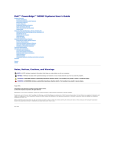
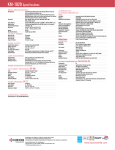
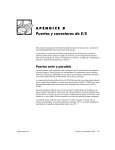
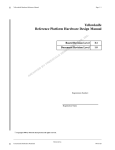

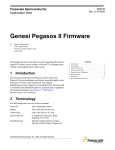
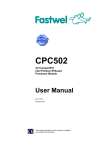

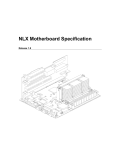

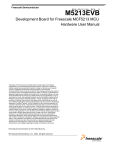
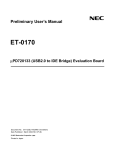
![UK User`s Manual [ Notebook ]](http://vs1.manualzilla.com/store/data/005694610_1-ad8e24898a53e900e9c2a73fa8f500a7-150x150.png)
